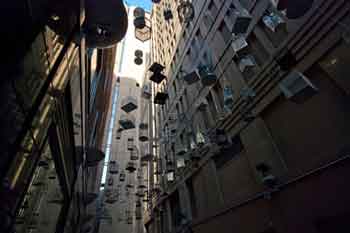Forgotten Songs

Forgotten Songs, by Michael Thomas Hill (completed 2011), a permanent installation at Angel Place, Sydney.
Forgotten Songs commemorates the songs of fifty birds once heard in central Sydney before they were gradually forced out of the city by European settlement. The calls, which filter down from the canopy of birdcages suspended above Angel Place, change as day shifts to night; the daytime birds songs disappearing with the sun and those of the nocturnal birds which inhabited the area sounding into the evening.
Birds
Habitat loss is credited as the biggest threat to bird survival. At present there are 129 species of birds native to New South Wales formally listed as extinct or threatened with extinction. The recordings you can hear in Forgotten Songs are from bird species that sang in central Sydney before Europeans settled and gradually forced them away. Some of these birds can still be heard on the city margins where they find food and shelter in thick native vegetation. Others have retracted still further.
During the day, you may hear the calls of the Eastern Whipbird, Rockwarbler, Regent Honeyeater, Grey Shrike-thrush, Fan-tailed Cuckoo, Spotted Pardalote, Brown Gerygone, Jacky Winter, Scarlet Robin, Golden Whistler, Leaden Flycatcher, Dollarbird, White-eared Honeyeater, Superb Lyrebird, Brown Thornbill, Varied Sittella, Brush Cuckoo, Dusky Woodswallow, Eastern Spinebill, White-throated Treecreeper, Little Lorikeet, Mistletoebird, Pallid Cuckoo, Red-browed Finch, Rufous Whistler, Brown-headed Honeyeater, Scarlet Honeyeater, Eastern Yellow Robin, Shining Bronze-Cuckoo, Southern Emu-wren, Spotted Quail-thrush, Striated Thornbill, Superb Fairy-wren, Tawny-crowned Honeyeater, Grey Fantail, Variegated Fairy-wren, Whistling Kite, White-browed Scrubwren, White-browed Woodswallow, White-naped Honeyeater, White- throated Gerygone, Wonga Pigeon, Yellow-faced Honeyeater and Yellow- tufted Honeyeater.
At night, you may hear the Australian Owlet-nightjar, Powerful Owl, Southern Boobook, Barn Owl, Tawny Frogmouth and White-throated Nightjar.
Science and Art
While working on an exhibition for the Australian Museum, the artist met scientist Dr Richard Major. Major works as the Australian Museum Ecologist and has researched bird species that have disappeared due to habitat loss in built-up areas, but also those opportunist species such as the White Ibis and Noisy Mynah that have benefited from the spread of the urban environment.
In developing the concept for the artwork, Hill approached Major to provide a list of bird species that may have lived in the Angel Place area before the arrival of Europeans. Major developed a schedule of the bird species based on the type of soil (therefore the type of vegetation that grew there) and also on the fact that the Tank Stream runs through the area and may have encouraged other different species to live close by. By examining the Australian Museum collection of bird skins gathered from various parts of the city from about 1850 onwards and using reasonable estimates based on similar vegetation types elsewhere in the Sydney area, Major created a list of 50 species of both diurnal and nocturnal birds. One of Majors colleagues, wildlife recordist Fred van Geseell, had recorded the birdsongs of all these species and provided the sound files for this project.
Some of of the songs can be heard on the Australian Museum/Birds Australia website, Birds in Backyards www.birdsinbackyards.net
Laneway Art
Forgotten Songs was originally commissioned as part of By George Hidden Networks, the Citys 2009 temporary laneway art program curated by Dr Steffen Lehmann from 1st October 2009 - 31st January 2010. In keeping with the brief for that year, which called for collaborations between artists, architects and one other, the work was collaboration between artist Michael Hill, scientist Dr Richard Major, designer Richard Wong and programmer Dave Towey.
The artwork proved immensely popular with Sydneysiders and visitors alike, transforming Angel Place with the sound of birdsong and transporting those that traversed the laneway back in time to listen to these forgotten songs on a daily basis. Due to the works success, the City of Sydneys Public Art Advisory Panel recommended to Council in March 2010 that the City should make the work permanent and incorporate it into the upgrade of Angel Place.
Michael Thomas Hill
The artist Michael Thomas Hill has been developing multimedia projects for museum and other public spaces with his company Lightwell for 8 years. He has produced video and interactive programs for the National Museum of Australia, ACMI, the Australian Museum, the National Archives and many others.
Originally studying painting at the National Art School, Michael completed a BA in Sculpture and Installation from Sydney College of Art (Sydney University), followed by an MA in Media Art from COFA (UNSW). He exhibited films and videos as a media artist before working with the Australian Film Commission, where he oversaw the production of interactive projects and experimental media.
Project Team
Artist - Michael Thomas Hill
Consulting Scientist - Dr Richard Major
Field Recordings - Fred van Gessel
Audio System Design and Programming - Lightwell
Graphic Design - Freeman Ryan Design
Landscape Architecture - Aspect Studios
❊ When ❊
Happens: Monday, Tuesday, Wednesday, Thursday, Friday, Saturday, Sunday
❊ Where ❊
℅ Warrane⊜ Angel Place Sydney Map
❊ Web Links ❊
→ Forgotten Songs→ www.cityofsydney.nsw.gov.au
→ Disclaimer: Details can change at any time. Always check with the advertiser before making plans, buying tickets or proceeding .. more
Update This Page








